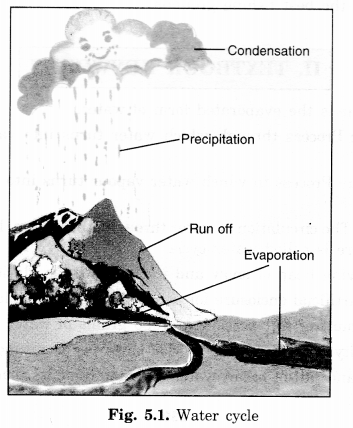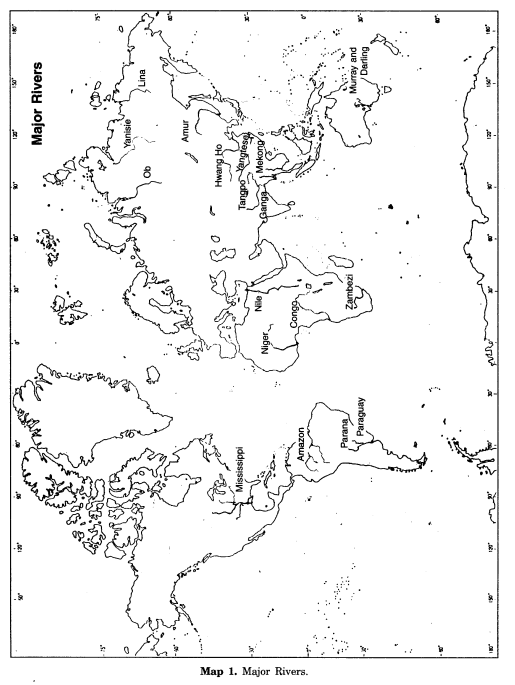NCERT Solutions for Class 7 Social Science Geography Chapter 5 Water are part of NCERT Solutions for Class 7 Social Science. Here we have given NCERT Solutions for Class 7 Social Science Geography Chapter 5 Water.
| Board | CBSE |
| Textbook | NCERT |
| Class | Class 7 |
| Subject | Social Science Geography |
| Chapter | Chapter 5 |
| Chapter Name | Water |
| Number of Questions Solved | 9 |
| Category | NCERT Solutions |
NCERT Solutions for Class 7 Social Science Geography Chapter 5 Water
NCERT TEXTBOOK EXERCISES
Question 1.
Answer the following questions.
- What is precipitation?
- What is the water cycle?
- What are the factors affecting the height of the waves?
- Which factors affect the movement of ocean water?
- What are tides and how are they caused?
- What are ocean currents?
Answer.
- Precipitation: Precipitation is the fall of moisture on the ground in the form of rainfall, snow, sleet and hailstones.
- Water Cycle:
- The sun’s heat causes evaporation of water from various water bodies.

- These vapors cools down, it condenses and forms clouds.
- Once the clouds reach saturation point, the water comes down in form of precipitation —rain, snow, dew, sleet etc.
- Rate of evaporation depends upon the sun’s heat and absorption capacity of air.
- The process in which the water changes its form and circulates between land, ocean, and air is called the water cycle.
- The sun’s heat causes evaporation of water from various water bodies.
- Factors affecting the height of the waves:
- Winds
- Earthquakes, volcanic eruptions and landslides on the bottom of the oceans.
- Factors affecting the movement of ocean water:
- Temperature
- Winds
- The gravitational pull of the sun, the earth, and the moon
- Shape of continents
- Warm and cold currents
- Salinity
- The rhythmic rise and fall of ocean water twice a day is called a tide. Tides are caused due to the gravitational pull exerted by the sun and the moon on the earth’s surface.
- Ocean currents are streams of water flowing constantly on the ocean surface in definite directions. They may be warm or cold currents:
- Warm currents originate near the equator and move towards the poles. They bring about warm temperatures over land surfaces, for example, the Gulf stream.
- Cold currents originate near poles and move towards tropical or lower latitudes. They bring about coolness over land surfaces, for example, Labrador current.
Question 2.
Give reasons.
- Ocean water is salty.
- The quality of water is deteriorating.
Answer.
- Ocean water is salty because it contains a large number of dissolved salts. Most of this salt is sodium chloride or common table salt.
- The quality of water is deteriorating because of the following reasons:
- The decrease in the water table.
- Mixing of industrial effluents and untreated water of industries into the streams, rivers, and even oceans.
- Mixing of sewerage water into the rivers etc.
- Excessive use of water causing scarcity.
- Throwing of dead bodies, havan ashes, vegetables, and flowers into the sea.
- Bathing of animals into the water bodies.
- Dirt and dust storms also pollute water.
Question 3.
Tick the correct answer.
(i) The process by which water continually changes its form and circulates between oceans, atmosphere and land
(a) Water cycle
(b) Tides
(c) Ocean currents
Answer.
(a) Water
(ii) Generally the warm ocean currents originate near
(a) Poles
(b) Equator
(c) None of these
Answer.
(b) the Equator.
(iii) The rhythmic rise and fall of ocean water twice in a day is called
(a) Tide
(b) Ocean current
(c) Wave
Answer.
(a) Tide.
Question 4.
Match the following.
(i) Caspian Sea (a) the Largest lake
(ii) Tide (b) Periodic rise and fall of water
(iii) Tsunami (c) Strong seismic waves
(iv) Ocean currents (d) Streams of water moving along definite paths
(e) Water cycle
Answer.
(i) Caspian Sea (a) the Largest lake
(ii) Tide (b) Periodic rise and fall of water
(iii) Tsunami (c) Strong seismic waves
(iv) Ocean currents (d) Streams of water moving along definite paths
Question 5.
For fun.
Be a Detective
(i) The name of one river is hidden in each of the sentences below. Spot it. Example: Mandira, Vijayalakshmi, and Surinder are my best friends
Answer.
Ravi
(a) The snake charmer’s bustee, stables where horses are housed, and the piles of wood, all caught fire accidentally. (Hint: Another name for River Brahmaputra)
(b) The conference manager put pad, material for reading, and a pencil for each participant. (Hint: A distributary on the Ganga-Brahmputra delta)
(c) Either jealousy or anger cause a person’s fall (Hint: Name of juicy fruit!)
(d) Bhavani germinated the seeds in a pot (Hint: Look for her in West Africa)
(e) “I am a zonal champion now” declared the excited athlete. (Hint: The river that has the biggest basin in the world)
(f) The tiffin box rolled down and all the food fell in dusty potholes. (Hint: Rises in India and journeys through Pakistan)
(g) Malini leaned against the pole when she felt that she was going to faint. (Hint: Her delta in Egypt is famous)
(h) Samantha mesmerised everybody with her magic tricks. (Hint: London is situated on her estuary)
(i) “In this neighbourhood, please don’t yell! Owners of these houses like to have peace.” Warned my father when we moved into our new flat.” (Hint: color!)
(j) ‘Write the following words, Marc!’ “On”, “go”, “in”— said the teacher, to the little boy in KG Class. (Hint: Rhymes with ‘bongo’)
Now make some more on your own and ask your classmates to spot the hidden name.-You can do this with any name: that of a lake, mountains, trees, fruits, school items, etc.
Answer.
(a) Teesta (a tributary of Brahmaputra)
(b) Padma
(c) Orange
(d) Niger
(e) Amazon
(f) Indus
(g) the Nile
(h) the Thames
(i) Yellow river
(j) Congo
Do further exercise yourself.
Carry on Detective
(ii) With the help of an atlas, draw each river which you discovered in For fun (/), on an outline map of the world.
Answer.

INTEXT QUESTIONS WITH THEIR ANSWERS
Question 1.
Why do so many countries face water scarcity? (NCERT Page 32)
Answer.
Due to the following reasons.
- Some countries are rocky and stony, and arid.
- Some do not have much rainfall.
- Some are desert areas.
- Most of the water is polluted, of inferior quality.
- Excessive use of water has depleted water resources.
Question 2.
Is all water on the earth available to us? (NCERT Page 32)
Answer.
No, only 3% is freshwater. It’s 0.3% is available to us.
Question 3.
Don’t you think we are wasting a precious resource when we use water carelessly? (NCERT Page 32)
Answer.
Yes.
Question 4.
When you are playing throw ball on the beach and the ball falls into the water, what happens? (NCERT Page 34)
Answer.
It goes up and down at its place. It gets back to the shore with the waves.
We hope the NCERT Solutions for Class 7 Social Science Geography Chapter 5 Water help you. If you have any query regarding NCERT Solutions for Class 7 Social Science Geography Chapter 5 Water, drop a comment below and we will get back to you at the earliest.